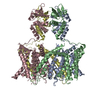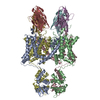+ Open data
Open data
- Basic information
Basic information
| Entry | Database: PDB / ID: 7ssv | ||||||
|---|---|---|---|---|---|---|---|
| Title | Structure of human Kv1.3 with Fab-ShK fusion | ||||||
 Components Components |
| ||||||
 Keywords Keywords |  IMMUNE SYSTEM / IMMUNE SYSTEM /  ion channel ion channel | ||||||
| Function / homology |  Function and homology information Function and homology informationdelayed rectifier potassium channel activity / corpus callosum development / voltage-gated monoatomic ion channel activity / Voltage gated Potassium channels / outward rectifier potassium channel activity / optic nerve development /  calyx of Held / calyx of Held /  voltage-gated potassium channel complex / potassium ion transmembrane transport / voltage-gated potassium channel complex / potassium ion transmembrane transport /  bioluminescence ...delayed rectifier potassium channel activity / corpus callosum development / voltage-gated monoatomic ion channel activity / Voltage gated Potassium channels / outward rectifier potassium channel activity / optic nerve development / bioluminescence ...delayed rectifier potassium channel activity / corpus callosum development / voltage-gated monoatomic ion channel activity / Voltage gated Potassium channels / outward rectifier potassium channel activity / optic nerve development /  calyx of Held / calyx of Held /  voltage-gated potassium channel complex / potassium ion transmembrane transport / voltage-gated potassium channel complex / potassium ion transmembrane transport /  bioluminescence / generation of precursor metabolites and energy / protein homooligomerization / potassium ion transport / bioluminescence / generation of precursor metabolites and energy / protein homooligomerization / potassium ion transport /  presynaptic membrane / presynaptic membrane /  postsynaptic membrane / postsynaptic membrane /  membrane raft / membrane raft /  axon / glutamatergic synapse / axon / glutamatergic synapse /  plasma membrane plasma membraneSimilarity search - Function | ||||||
| Biological species |   Homo sapiens (human) Homo sapiens (human)  Aequorea victoria (jellyfish) Aequorea victoria (jellyfish)unidentified (others) | ||||||
| Method |  ELECTRON MICROSCOPY / ELECTRON MICROSCOPY /  single particle reconstruction / single particle reconstruction /  cryo EM / Resolution: 3.39 Å cryo EM / Resolution: 3.39 Å | ||||||
 Authors Authors | Meyerson, J.R. / Selvakumar, P. / Smider, V. / Huang, R. | ||||||
| Funding support |  United States, 1items United States, 1items
| ||||||
 Citation Citation |  Journal: Nat Commun / Year: 2022 Journal: Nat Commun / Year: 2022Title: Structures of the T cell potassium channel Kv1.3 with immunoglobulin modulators. Authors: Purushotham Selvakumar / Ana I Fernández-Mariño / Nandish Khanra / Changhao He / Alice J Paquette / Bing Wang / Ruiqi Huang / Vaughn V Smider / William J Rice / Kenton J Swartz / Joel R Meyerson /  Abstract: The Kv1.3 potassium channel is expressed abundantly on activated T cells and mediates the cellular immune response. This role has made the channel a target for therapeutic immunomodulation to block ...The Kv1.3 potassium channel is expressed abundantly on activated T cells and mediates the cellular immune response. This role has made the channel a target for therapeutic immunomodulation to block its activity and suppress T cell activation. Here, we report structures of human Kv1.3 alone, with a nanobody inhibitor, and with an antibody-toxin fusion blocker. Rather than block the channel directly, four copies of the nanobody bind the tetramer's voltage sensing domains and the pore domain to induce an inactive pore conformation. In contrast, the antibody-toxin fusion docks its toxin domain at the extracellular mouth of the channel to insert a critical lysine into the pore. The lysine stabilizes an active conformation of the pore yet blocks ion permeation. This study visualizes Kv1.3 pore dynamics, defines two distinct mechanisms to suppress Kv1.3 channel activity with exogenous inhibitors, and provides a framework to aid development of emerging T cell immunotherapies. | ||||||
| History |
|
- Structure visualization
Structure visualization
| Structure viewer | Molecule:  Molmil Molmil Jmol/JSmol Jmol/JSmol |
|---|
- Downloads & links
Downloads & links
- Download
Download
| PDBx/mmCIF format |  7ssv.cif.gz 7ssv.cif.gz | 346.7 KB | Display |  PDBx/mmCIF format PDBx/mmCIF format |
|---|---|---|---|---|
| PDB format |  pdb7ssv.ent.gz pdb7ssv.ent.gz | 261.2 KB | Display |  PDB format PDB format |
| PDBx/mmJSON format |  7ssv.json.gz 7ssv.json.gz | Tree view |  PDBx/mmJSON format PDBx/mmJSON format | |
| Others |  Other downloads Other downloads |
-Validation report
| Arichive directory |  https://data.pdbj.org/pub/pdb/validation_reports/ss/7ssv https://data.pdbj.org/pub/pdb/validation_reports/ss/7ssv ftp://data.pdbj.org/pub/pdb/validation_reports/ss/7ssv ftp://data.pdbj.org/pub/pdb/validation_reports/ss/7ssv | HTTPS FTP |
|---|
-Related structure data
| Related structure data |  25414MC  7ssxC  7ssyC  7sszC  8dflC M: map data used to model this data C: citing same article ( |
|---|---|
| Similar structure data | Similarity search - Function & homology  F&H Search F&H Search |
| EM raw data |  EMPIAR-11081 (Title: Human Kv1.3 with a Fab-ShK fusion / Data size: 2.0 TB EMPIAR-11081 (Title: Human Kv1.3 with a Fab-ShK fusion / Data size: 2.0 TBData #1: Human Kv1.3 ShK-Fab dataset [micrographs - multiframe]) |
- Links
Links
- Assembly
Assembly
| Deposited unit | 
|
|---|---|
| 1 |
|
- Components
Components
| #1: Protein | Mass: 95018.500 Da / Num. of mol.: 4 Source method: isolated from a genetically manipulated source Source: (gene. exp.)   Homo sapiens (human), (gene. exp.) Homo sapiens (human), (gene. exp.)   Aequorea victoria (jellyfish) Aequorea victoria (jellyfish)Gene: KCNA3, HGK5, GFP / Production host:   Homo sapiens (human) / References: UniProt: P22001, UniProt: P42212 Homo sapiens (human) / References: UniProt: P22001, UniProt: P42212#2: Antibody | | Mass: 29417.229 Da / Num. of mol.: 1 Source method: isolated from a genetically manipulated source Source: (gene. exp.) unidentified (others) / Production host:   Homo sapiens (human) Homo sapiens (human)#3: Antibody | | Mass: 22524.752 Da / Num. of mol.: 1 Source method: isolated from a genetically manipulated source Source: (gene. exp.) unidentified (others) / Production host:   Homo sapiens (human) Homo sapiens (human)#4: Chemical | Has ligand of interest | Y | |
|---|
-Experimental details
-Experiment
| Experiment | Method:  ELECTRON MICROSCOPY ELECTRON MICROSCOPY |
|---|---|
| EM experiment | Aggregation state: PARTICLE / 3D reconstruction method:  single particle reconstruction single particle reconstruction |
- Sample preparation
Sample preparation
| Component | Name: Kv1.3 with Fab-ShK / Type: COMPLEX / Entity ID: #1-#3 / Source: MULTIPLE SOURCES |
|---|---|
| Molecular weight | Units: MEGADALTONS |
| Source (natural) | Organism:   Homo sapiens (human) Homo sapiens (human) |
| Source (recombinant) | Organism:   Homo sapiens (human) Homo sapiens (human) |
| Buffer solution | pH: 7.5 |
| Specimen | Embedding applied: NO / Shadowing applied: NO / Staining applied : NO / Vitrification applied : NO / Vitrification applied : YES : YES |
Vitrification | Cryogen name: ETHANE |
- Electron microscopy imaging
Electron microscopy imaging
| Experimental equipment |  Model: Titan Krios / Image courtesy: FEI Company |
|---|---|
| Microscopy | Model: FEI TITAN KRIOS |
| Electron gun | Electron source : :  FIELD EMISSION GUN / Accelerating voltage: 300 kV / Illumination mode: OTHER FIELD EMISSION GUN / Accelerating voltage: 300 kV / Illumination mode: OTHER |
| Electron lens | Mode: BRIGHT FIELD Bright-field microscopy Bright-field microscopy |
| Image recording | Electron dose: 54 e/Å2 / Film or detector model: GATAN K3 BIOQUANTUM (6k x 4k) |
- Processing
Processing
CTF correction | Type: PHASE FLIPPING AND AMPLITUDE CORRECTION |
|---|---|
3D reconstruction | Resolution: 3.39 Å / Resolution method: FSC 0.143 CUT-OFF / Num. of particles: 90267 / Symmetry type: POINT |
 Movie
Movie Controller
Controller





 PDBj
PDBj










